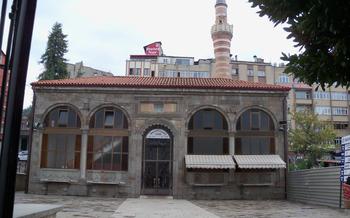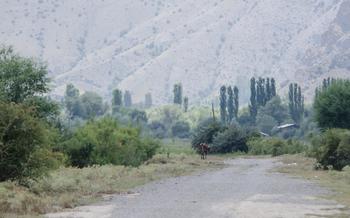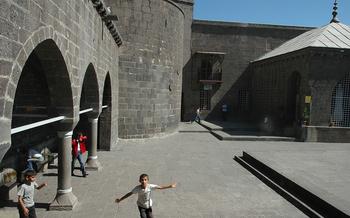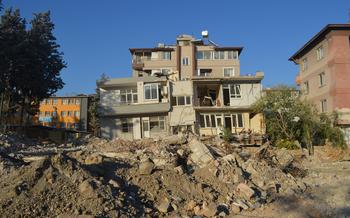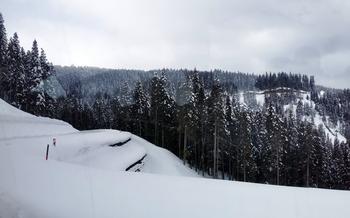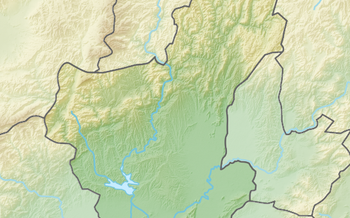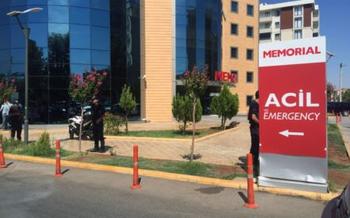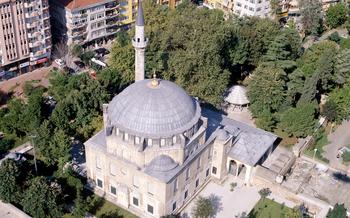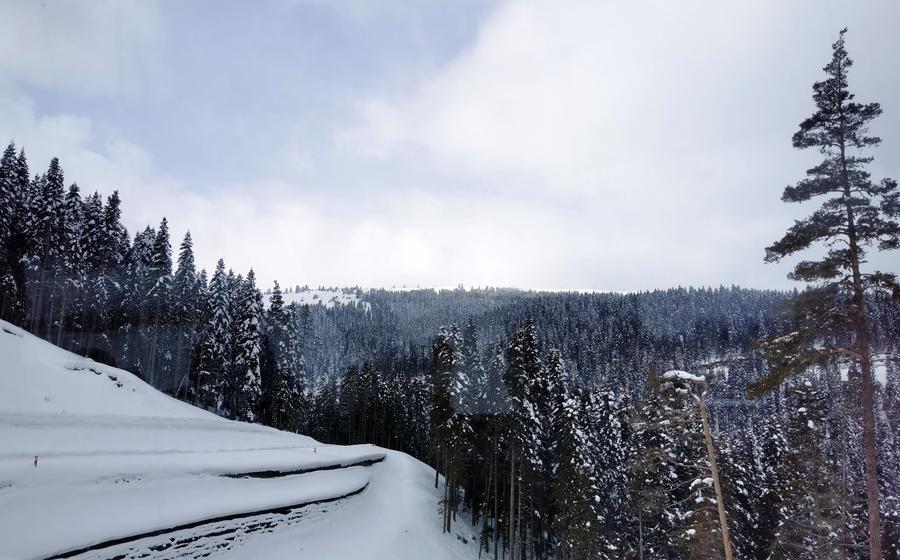
Kastamonu Atabeygazi Mosque
- Kastamonu Atabeygazi Mosque: A Historical Masterpiece
- The Enchanting Town of Kastamonu
- Exploring the Atabeygazi Mosque
- Marveling at the Architecture
- Stepping Back in Time
- A Place of Worship and Serenity
- The Minaret: A Symbol of Faith
- The Courtyard: A Peaceful Oasis
- The Prayer Hall: A Sanctuary for Worship
- The Museum: Unveiling the Past
- The Local Community: A Warm Embrace
- Off-the-Beaten-Path Gems
- Capturing the Essence: Photography Tips
- Insider Tip: Unveiling a Hidden Gem
Kastamonu Atabeygazi Mosque: A Historical Masterpiece
The Kastamonu Atabeygazi Mosque stands as a testament to the rich history and architectural heritage of Turkey. Built in the 13th century during the reign of the Seljuk Sultan, Kayqubad I, the mosque holds a significant place in Islamic architecture and is considered one of the finest examples of Seljuk craftsmanship. With its intricate carvings, graceful dome, and awe-inspiring minaret, the mosque attracts visitors from around the world who come to marvel at its beauty and historical significance.
The Atabeygazi Mosque is not just a religious site but also a cultural landmark that embodies the essence of Kastamonu. It has witnessed centuries of history, from the rise and fall of empires to the transformation of Kastamonu into a vibrant and multicultural city. The mosque's architectural features, including its unique Seljuk style, reflect the artistic and cultural influences that shaped Kastamonu's identity. Whether you are a history buff, an architecture enthusiast, or simply a traveler seeking cultural immersion, the Kastamonu Atabeygazi Mosque is a must-visit destination that will leave you in awe.
The Enchanting Town of Kastamonu
Nestled amidst the picturesque landscapes of northern Turkey, lies the captivating town of Kastamonu, a hidden gem waiting to be explored. With a rich history dating back to ancient times, Kastamonu exudes a timeless charm that blends seamlessly with its modern-day vibrancy.
Strategically located at the crossroads of major trade routes, Kastamonu has long served as a cultural and commercial hub, attracting diverse influences from various civilizations. This rich heritage is reflected in the town's captivating tapestry of architectural wonders, historical landmarks, and natural beauty.
As you stroll through the cobbled streets of Kastamonu, you'll be greeted by a harmonious blend of Ottoman, Seljuk, and Byzantine influences. The town's historic center is a treasure trove of architectural marvels, with grand mansions, traditional houses, and iconic mosques showcasing the region's rich artistic legacy.
Beyond its architectural wonders, Kastamonu offers a plethora of captivating experiences for visitors. Immerse yourself in the vibrant local markets, where you can haggle for unique souvenirs and sample delicious regional delicacies. Explore the town's fascinating museums, which house a wealth of artifacts and exhibits that shed light on Kastamonu's storied past.
Whether you're a history buff, a nature enthusiast, or simply a traveler seeking authentic cultural experiences, Kastamonu promises an unforgettable journey. Discover the hidden gems of this enchanting town, where history, culture, and natural beauty intertwine to create a truly magical destination.
Top attractions and things to do in Kastamonu:
- Marvel at the architectural wonders of the Kastamonu Atabeygazi Mosque, a stunning example of Seljuk architecture.
- Embark on a culinary adventure, savoring the town's delectable specialties such as "Kastamonu mantısı" and "Kastamonu kebabı."
- Delve into the town's rich history at the Kastamonu Museum, which houses a fascinating collection of artifacts and exhibits.
- Immerse yourself in the vibrant local culture by visiting the bustling markets and engaging with the friendly locals.
- Explore the scenic surroundings of Kastamonu, including the breathtaking Ilıca Waterfall and the lush forests of the Küre Mountains.
Exploring the Atabeygazi Mosque
The Atabeygazi Mosque welcomes visitors to delve into its captivating history and architectural brilliance. Guided tours are available for a comprehensive exploration, providing insights into the mosque's construction, design, and significance. These tours offer a deeper understanding of the mosque's historical context and its role in the cultural fabric of Kastamonu.
For those who prefer self-exploration, detailed information panels are placed strategically throughout the mosque, offering valuable information about its various features. Take your time to wander through the mosque's serene spaces, admiring the intricate details and absorbing the spiritual atmosphere.
Highlights to look out for include the exquisite carvings and inscriptions that adorn the walls, the graceful dome that crowns the mosque, and the beautifully decorated Mihrab, a niche indicating the direction of prayer. The mosque's courtyard provides a tranquil oasis, inviting visitors to pause and reflect amidst the serene surroundings.
Marveling at the Architecture
The Atabeygazi Mosque stands as a testament to the artistry and craftsmanship of the Seljuk era. Its architectural style is distinctly Seljuk, characterized by intricate carvings, decorative elements, and the graceful dome that crowns the structure.
The exterior of the mosque is adorned with intricate carvings and inscriptions, each telling a story from the mosque's rich history. The decorative elements, such as floral motifs and geometric patterns, add a touch of elegance and sophistication to the overall design.
The mosque's dome is a masterpiece of Islamic architecture. Its graceful curves and elegant proportions create a sense of awe and wonder. The dome is supported by four massive pillars, each adorned with intricate carvings and inscriptions. The interior of the dome is decorated with stunning paintings and mosaics, creating a celestial atmosphere that inspires tranquility and devotion.
Stepping Back in Time
The Kastamonu Atabeygazi Mosque stands has played a pivotal role in the community's religious and social life for centuries. Over the years, many stories and legends have been woven around the mosque, adding to its mystique and allure.
According to local folklore, the mosque was built on the site of a former Byzantine church, symbolizing the transition from one era to another. It is believed that the mosque's construction was initiated by a pious and benevolent ruler named Atabey, who sought to create a sacred space that would unite the community and promote religious harmony.
The mosque has witnessed numerous historical events and changes in Kastamonu's political and social landscape. It has served as a place of refuge and solace during turbulent times, and its walls have echoed with the prayers and supplications of countless devotees.
Today, the Kastamonu Atabeygazi Mosque stands as a symbol of Kastamonu's enduring cultural heritage. It is a reminder of the city's rich past, its diverse religious traditions, and the harmonious coexistence of different faiths throughout history.
A Place of Worship and Serenity
Despite its historical significance and architectural beauty, the Kastamonu Atabeygazi Mosque remains an active place of worship. Its doors are open to worshippers of all ages, and the atmosphere within is one of tranquility and devotion. As visitors step inside, they are enveloped by a sense of serenity, a reminder of the sacred nature of this space.
Respecting local customs and etiquette is essential when visiting the mosque. Visitors should dress modestly, avoid loud conversations and disruptive behavior, and refrain from taking photographs during prayer times. By observing these simple guidelines, visitors can contribute to the peaceful and respectful atmosphere of the mosque and ensure that worshippers can continue to practice their faith in a serene environment.
The Minaret: A Symbol of Faith
The tall and slender minaret of the Kastamonu Atabeygazi Mosque is a prominent landmark that can be seen from various points in the city. Rising gracefully towards the sky, the minaret is a symbol of faith and devotion. Its intricate tilework and decorative elements add to its beauty and significance. The minaret serves as a reminder of the mosque's role in the call to prayer, which echoes through the streets of Kastamonu five times a day, summoning the faithful to prayer. In Islam, the minaret holds a special place, as it represents the connection between the earthly realm and the divine. The muezzin's call from the minaret not only invites Muslims to prayer but also serves as a reminder of the presence of God and the importance of faith in everyday life.
The Courtyard: A Peaceful Oasis
Encompassing the mosque is a spacious and serene courtyard that radiates tranquility and invites contemplation. This outdoor space serves as an extension of the mosque, offering a sanctuary for both religious gatherings and moments of quiet reflection. The courtyard's expansive layout provides ample room for worshippers to congregate and engage in various activities, fostering a sense of community and unity.
The courtyard's design seamlessly blends functionality with aesthetics. Intricate stone pathways guide visitors through the space, connecting different sections of the mosque and creating a harmonious flow. The pathways are flanked by well-manicured gardens, adding a touch of color and vibrancy to the surroundings. Visitors can find respite amidst the lush greenery, enjoying the shade of towering trees and the fragrance of blooming flowers.
Water features, a hallmark of Islamic architecture, enhance the tranquility of the courtyard. Cascading fountains and gentle streams create a soothing soundscape, inviting visitors to pause and appreciate the serene ambiance. The rhythmic flow of water symbolizes the continuous cycle of life and renewal, reminding visitors of the spiritual significance of the mosque.
The courtyard is not merely a transitional space but a destination in its own right. It serves as a venue for religious gatherings, such as outdoor prayers and festivals. During these events, the courtyard transforms into a vibrant hub of activity, filled with the sounds of recitation, supplication, and celebration. The courtyard's ability to accommodate large gatherings speaks to the mosque's importance as a center of community life.
Whether seeking a moment of solitude or immersing oneself in the vibrant atmosphere of religious events, the courtyard of the Kastamonu Atabeygazi Mosque offers a truly unique experience. It is an oasis of peace and tranquility, where visitors can connect with their spiritual side and appreciate the beauty of Islamic architecture.
The Prayer Hall: A Sanctuary for Worship
At the heart of the Kastamonu Atabeygazi Mosque lies the vast and elegant prayer hall, inviting the faithful to immerse themselves in spiritual contemplation and communion. The hall's expansive dimensions create a sense of awe, while intricate designs and patterns adorning the walls and ceiling add a touch of celestial beauty.
The Mihrab, the sacred niche indicating the direction of prayer, stands as the focal point of the prayer hall. Its intricate carvings and delicate calligraphy draw the eye and serve as a reminder of the divine presence. The Mihrab not only serves as a symbolic guide during prayer but also represents the connection between the earthly realm and the divine.
As sunlight filters through the stained-glass windows, casting a warm glow on the rich carpets, a sense of serenity and tranquility envelops the prayer hall. The soft murmur of prayers and the rhythmic movements of worshippers create a harmonious symphony of devotion, transporting visitors to a realm of spiritual transcendence.
The Museum: Unveiling the Past
Enhancing the experience of visiting the Kastamonu Atabeygazi Mosque is the on-site museum, a treasure trove of knowledge and artifacts that shed light on the mosque's rich history and significance. Within its walls, visitors can embark on a journey through time, delving into the mosque's past and its place in Kastamonu's cultural and religious tapestry.
The museum's collection boasts a diverse array of exhibits, including historical documents, manuscripts, and relics that provide a deeper understanding of the mosque's construction, design, and evolution over the centuries. Visitors can trace the mosque's transformation from its initial conception to its present-day grandeur, gaining insights into the architectural influences and the skilled craftsmanship that brought it to life.
Among the museum's highlights are rare manuscripts that document the mosque's foundation and subsequent renovations. These precious texts offer a glimpse into the minds of the architects and builders who dedicated their lives to creating this architectural masterpiece. Additionally, the museum showcases artifacts unearthed during archaeological excavations around the mosque, providing tangible evidence of the site's long and storied history.
A visit to the museum is an essential complement to exploring the Kastamonu Atabeygazi Mosque. It allows visitors to delve beneath the surface and uncover the hidden stories that lie within the mosque's walls. Through its exhibits, the museum brings the past to life, enhancing the appreciation and understanding of this magnificent architectural gem.
The Local Community: A Warm Embrace
The people of Kastamonu are renowned for their warm hospitality and welcoming nature, ensuring that visitors feel at home from the moment they arrive. Engaging with locals offers a unique opportunity to immerse oneself in the town's rich culture and traditions. Whether it's striking up a conversation at a local teahouse, exploring the vibrant markets, or attending traditional festivals, there are countless chances to connect with the friendly locals and gain a deeper understanding of their way of life. The town's annual festivals, such as the Kastamonu Culture and Art Festival, provide a vibrant showcase of local music, dance, and handicrafts, allowing visitors to experience the infectious energy and camaraderie of the community. Embracing the local culture and interacting with the people of Kastamonu is an essential part of any visit, creating lasting memories and fostering a sense of connection with this special place.
Off-the-Beaten-Path Gems
Beyond the main tourist trail, Kastamonu hides a treasure trove of hidden corners and lesser-known spots waiting to be discovered. Take a leisurely stroll through the surrounding neighborhoods and uncover local secrets that often go unnoticed by the casual visitor. Admire traditional Ottoman-era houses, visit quaint local shops, and engage with friendly residents who are always eager to share stories and insights about their beloved city.
Explore the nearby Kazandere Valley, a verdant oasis just a short walk from the mosque. Amidst the lush greenery, you'll find cascading waterfalls, serene picnic spots, and ancient rock formations that tell tales of a bygone era. For a truly immersive experience, venture into the surrounding countryside and visit traditional villages where time seems to stand still. Meet local artisans, learn about their crafts, and savor the flavors of authentic Turkish cuisine.
Capturing the Essence: Photography Tips
Harness the Power of Natural Light: Time your visit to coincide with the golden hours of sunrise or sunset to capture the most flattering light. The warm hues of this natural light will enhance the colors and textures of the mosque, creating a magical and ethereal ambiance.
Master the Art of Composition: Experiment with different angles and perspectives to create visually appealing compositions. Utilize leading lines, such as the arches and columns, to draw the viewer's eye toward the mosque's captivating features.
Embrace Detail and Texture: Focus on the intricate carvings, inscriptions, and decorative elements that adorn the mosque's exterior and interior. These details add depth and character to your photographs, showcasing the artistry and craftsmanship that went into its construction.
Capture the Essence of the Courtyard: The serene courtyard, with its lush greenery, water features, and elegant architecture, provides ample opportunities for stunning shots. Experiment with different focal lengths to capture the grandeur of the mosque while incorporating the tranquil ambiance of the courtyard.
Experiment with Long Exposure: If you're feeling adventurous, try your hand at long exposure photography to capture the movement of clouds or the shimmering reflections in the courtyard's water features. This technique can add a touch of drama and dynamism to your images.
Insider Tip: Unveiling a Hidden Gem
As you explore the captivating city of Kastamonu, take a moment to venture off the beaten path and discover a hidden gem that lies just a stone's throw from the Atabeygazi Mosque. Tucked away in a quiet corner, you'll find a small, unassuming teahouse that has been serving locals and travelers alike for generations. Step inside and immerse yourself in the warmth and authenticity of this hidden treasure.
Savor the aroma of freshly brewed tea as you mingle with the friendly locals, who will gladly share stories and insights into Kastamonu's rich history and culture. Don't miss the chance to sample the delectable local pastries, which are a testament to the region's culinary heritage.
As you sip your tea and soak in the ambiance, you'll feel a sense of tranquility and connection to the heart of Kastamonu. This hidden teahouse is a true gem, waiting to be uncovered by those who seek authentic experiences beyond the main tourist trail.
Whether you're a history buff, a passionate photographer, or simply someone who appreciates the beauty of hidden gems, this charming teahouse is a must-visit during your exploration of Kastamonu. Let the warmth of the local hospitality and the flavors of traditional Turkish delights create lasting memories that will stay with you long after your visit.
